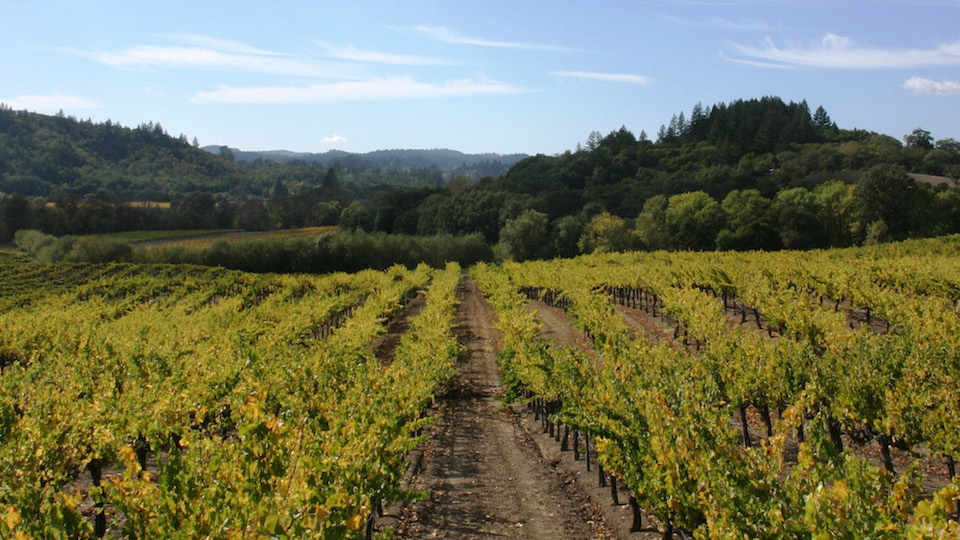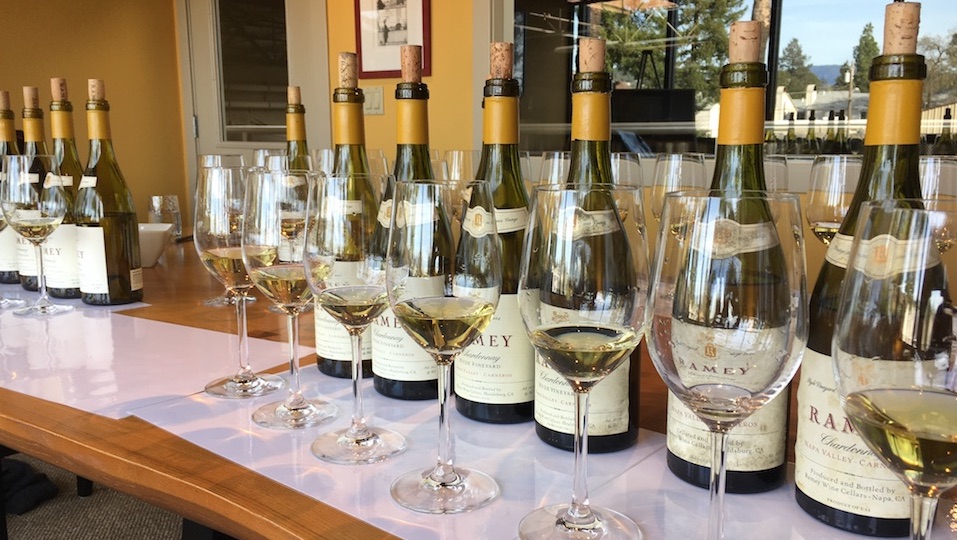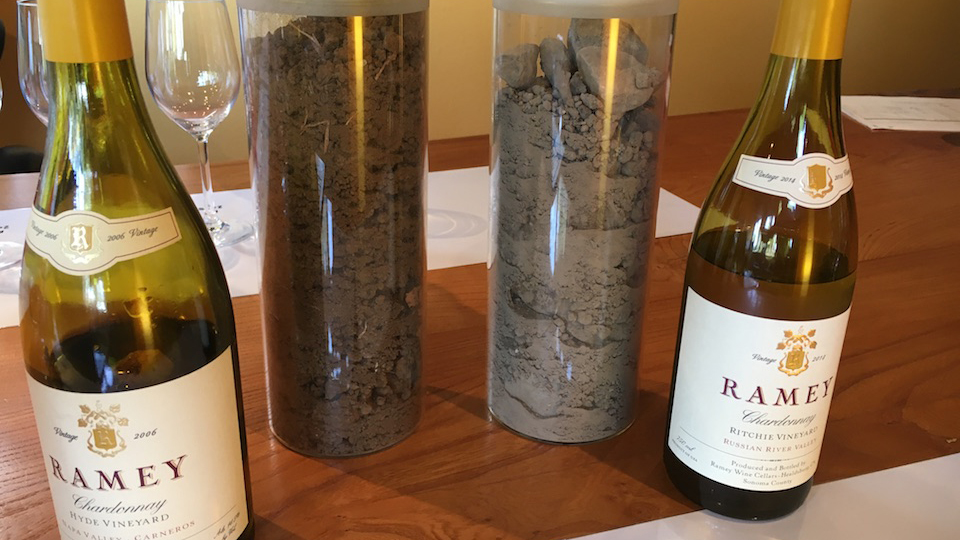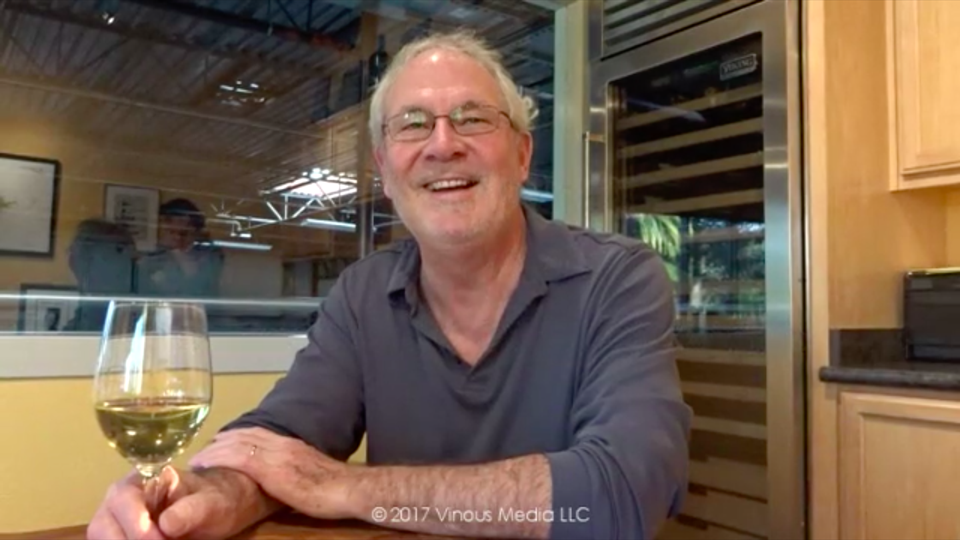Browse using the new Vinous website now. Launch →
Printed by, and for the sole use of . All rights reserved © 2015 Vinous Media
Verticals of Ramey’s Hyde and Ritchie Vineyard Chardonnays
BY STEPHEN TANZER | JULY 26, 2017
The invitation from David Ramey was one that I couldn’t resist. “We’ll taste my Ritchie and Hyde Vineyard Chardonnays as far back as I still have bottles. And if we find a tired bottle, I’ll open more until we get a good one,” he said. “My Chardonnays need time in the cellar, and none of them should be over the hill, even at age 15. If we find a bad bottle, but then the next one is full of life, the problem has to be the cork. That’s the only variable.”
This was a bold claim, particularly as most California Chardonnays are best within the two or three years after their release and all but a handful of producers suggest drinking their wines within six to eight years from the harvest. On the other hand, Ramey is a long-time student of Burgundy and an indisputable master of Chardonnay. Back in 1987, while at Matanzas Creek, he was the first California winemaker to whole-cluster press non-sparkling Chardonnay in order to minimize oxidizable tannins in his wines, an approach that has since become the industry standard. Since that time, no other winemaker on the West Coast has bottled a larger range and volume of outstanding Chardonnays. One almost takes the constant stream of 90+-point Chardonnays for granted from this remarkably consistent winemaker.

Hyde Vineyard
And Ramey is convinced that the wines he’s making today will age even better - and more consistently - than his past vintages, since he has switched entirely to molded agglomerated Diam corks as of vintage 2013. He uses Diam 10s (i.e., “guaranteed to remain free of cork taste and organoleptic deviation” for at least ten years) for his Chardonnays and the denser Diam 30s for his Cabernets and Bordeaux blends. Beyond their purity, these corks also provide for more consistent oxygen transmission rates than traditional corks and do a better job of preserving the free SO2 in wines, thus slowing the evolution of the wine in the bottle. (On the subject of corks and other factors critical to the longevity of Chardonnay, see my accompanying video interview with Ramey.)
David Ramey’s Long Chardonnay History
Over the past 30+ years, David Ramey has served as winemaker for Matanzas Creek, Chalk Hill, Dominus Estate and Rudd Estate, and he made Chardonnays at all of them. Christian Moueix allowed Ramey to begin his own label (Ramey Wine Cellars) in 1996, while he was at Dominus, with a wine from Larry Hyde’s vineyard in Carneros, which Ramey made in the Luna cellars with his friend John Kongsgaard. Ramey added a Hudson Vineyard bottling to his line-up in 1997, then began making Russian River Valley and Carneros Chardonnays in 2000. He introduced Cabernet to the Ramey Wine Cellars portfolio in 2001 and added Syrah in 2005. The 1998 through 2001 vintages were made at Rudd Estate, but then Ramey moved his operation to Healdsburg, sharing space to vinify in 2002 and then moving into his own facility the following year. Ramey made his first major purchase of vineyards in 2012 when he bought a 75-acre property on Westside Road across from Williams-Selyem, which includes 32 acres of Chardonnay vines and 10.5 of Pinot Noir.
David Ramey on Corks and the Ageability of Chardonnay
At the outset, Ramey offered sizable quantities of such “appellation wines” as his Chardonnay Russian River Valley and Chardonnay Sonoma Coast, which he has always described as his village wines, as well as smaller quantities of vineyard-designated wines—Hudson and Hyde vineyards at the beginning (he dropped Hudson after the 2011 vintage), then Ritchie in 2002, Platt Vineyard in 2009 through 2014, Woolsey Road in 2012, and Westside Farms in 2014. He refers to the latter wines as his premier crus (a less-modest producer, or one less familiar with the wines of Burgundy, undoubtedly would have elevated them to grand cru status). And he will offer a Rochioli Vineyard Chardonnay with vintage 2015, from fruit he purchases from the Rochiolis.
Ramey’s Chardonnays are rich but never over the top, often a bit tight on release but capable of gaining in complexity and pliancy with cellaring. You can find California Chardonnays that are flashier in their youth (such wines are often higher in alcohol, lower in acidity and more tropical in their fruit character) but very few of them demonstrate structure and aging curves more like Burgundies than typical New World Chardonnays, as Ramey’s do. Ramey most enjoys drinking his Chardonnays eight to ten years after the vintage, when they become smoother and plusher and show more bottle bouquet and complexity—as opposed simply to the grapey esters and fermentation notes shown by so many young California Chardonnays upon release. “I like them when they get biscuity and oatmealy, but hopefully short of caramelly, which normally occurs at about 15 years,” he explained. But during our tasting in March at his winery in Healdsburg, he frequently emphasized that there’s no reason his Chardonnays can’t last for 15 years or more—especially the wines he’s making today.
When Ramey showcases his Chardonnay to consumers on the road, he frequently pours two vintages of the same bottling ten years apart. “You can serve the younger version with plain grilled salmon and the older wine with salmon poached in butter with a sauce,” he tells his fellow tasters. “They’re just two different wines; one isn’t better than the other.” He makes the point that “although the wines are capable of lasting a long time, they don’t need to age in order to be drinkable.”

Ritchie Vineyard
Winemaking Techniques
Ramey considers Chardonnay to be “the red wine of white wine.” He also describes Chardonnay as “a made wine.” He explained: “We are low intervention in the sense of using native bacteria and native yeasts, of leaving our wines on their lees for 19 or 20 months, and then bottle them without filtration. But Chardonnay needs to be fermented in barrels and it needs to complete malolactic fermentation. You would simplify Chardonnay if you skipped either of these processes. Without them, your wine would be more like Pinot Grigio.”
Ramey told me that he would “essentially like to make the same wine every year” but quickly added that he doesn't do much to accomplish this. For example, he acidifies with a light hand, and then only in the juice tank before the must goes to the barrels for fermentation. And he’s more likely to employ this measure when pHs are high, not simply because natural acidity levels in the grapes are low. “Acidification of Chardonnay and Pinot Noir is absolutely common in Burgundy, and they’ve been at it for hundreds of years,” he explained. In California, vine leafroll disease, a set of viruses that, among other things, typically delays grape maturity, can also result in higher levels of malic acidity, so sometimes this fruit also needs to be acidified or else the wines would turn out too soft after the malolactic transformation occurs.
Ramey presses whole clusters in order to avoid tearing the grape skins and to minimize phenolic content in the must. “We minimize oxidizable tannins by limiting their extraction,” he explained. He doesn’t care much about fermentation temperatures but notes that they typically reach the high 70s. In the early days, Ramey used about two-thirds new oak barrels for his Chardonnays but that percentage has decreased over the years and is now more like 30% - and headed to 20% (and just 15% for his “village” wines).
As to alcohol levels, Ramey has been picking his Chardonnay - and especially his Hyde fruit - at lower Brix levels since about 2009. His target is now around 23 degrees Brix (or wines with about 14% potential alcohol, depending on the alcohol conversion factor), down from 24 to 24.5 in the early days.
Ramey told me that he has never filtered a Chardonnay under his eponymous label. As the Diam corks - so-called “technical closures” - preserve SO2 in the bottle better than traditional corks do, he has been able to cut back on his use of SO2, although he routinely bottles with high amounts of CO2. And the bottling takes place after extended élevage, when the wines are stable.

A double vertical of Ramey Chardonnay
Ramey’s Changing Tastes
Ramey noted that he is “aware of the zeitgeist in the sommelier echo chamber, which is critical of high-alcohol, overoaked wines,” but insists that the changing style of his Chardonnays in recent years is more a result of the evolution in his own personal tastes. “I enjoy a wide variety of fresh, unoaked white wines from around the world. When I drink them and then move on to a glass of our Chardonnay, the oak can stand out, and I don’t like that.” After carrying out experiments several years ago with barrels of varying ages, Ramey reached the conclusion that once- and twice-used barrels still significantly marked the wines. So whereas in the past he used one- and two-year-old barrels when he didn’t use new ones, today he typically uses his barrels for five years.
Unlike some of his colleagues, Ramey is convinced that long aging on the lees is a key to longevity for Chardonnay. Today, many researchers believe that the reducing compound glutathione, which is an anti-oxidant, is a significant factor in wine ageability. As Ramey’s Chardonnays test high for glutathione, he has come to believe that extended contact with the lees facilitates the extraction, or release, of this substance. He also believes that bâtonnage is a constructive step IF it’s done properly. For example, he carefully tops up his barrels before he stirs the lees to avoid introducing oxygen. “It’s a myth that the yeasts are dead; they have just run out of sugar,” he explained. “Even if only a portion of them are still alive, they would love to scavenge any available oxygen. Yeasts provide a reductive action; they keep the wines in a reductive stage of low oxygen, which retards oxidation. You don’t want to challenge that by adding oxygen.” He went on: “The bâtonnage helps us incorporate the oak; it keeps the wine fresh and it helps to metabolize the diacetyls during the malolactic fermentation to prevent the wine from having an excessive butterscotch character. But as soon as the malo finishes and the wine is sulfured, bâtonnage becomes unimportant.”
There’s frequently a note of positive reduction in Ramey’s Chardonnays, as there is in many white Burgundies. “It has to do with the amount of solids in the wines, which can give a gunflinty quality,” said Ramey. “Also, grape solids may still have traces of sulfur dioxide from the vineyards. I think of this element of reduction in Chardonnay as an affectation of the cellar. As with brettanomyces, it’s not an element of terroir, but it can add to a wine’s complexity in small doses.”

Two vineyards and their very different soils
The Hyde and Ritchie Vineyards
Of the three AVAs Ramey works with for Chardonnay - Russian River Valley, Carneros and Sonoma Coast - Carneros is the warmest, in spite of its cooling marine breezes. When Ramey first made his Hyde Vineyard bottling, he drew from a mixture of Wente clones and what is now called Clone 4, both planted by Larry Hyde in 1980. Nowadays the Hyde wine comes from two blocks of vines planted in 1997 and 1999 to Wente clones, which give small clusters and berries and a lot of shot berries without seeds (millerandage). “Carneros is basically an old exposed bay bottom with barely 30 inches of workable clay-loam on top of about 30 feet of impenetrable clay hard pan,” said Ramey, who added that, in addition to the right climate, he looks for low organic matter in the soil and good drainage when selecting sites for Chardonnay. “At Hyde, the thin layer of clay-loam limits the vines’ vigor, and that is essential.” He’s normally among the first harvesters of Hyde Chardonnay, notes Ramey. (Hyde fruit also supplies other top Chardonnay producers, including Hyde de Villaine, Kistler, Aubert Wines and Patz & Hall).
Ramey has been working with the same 19 rows of vines in Ritchie Vineyard in Russian River Valley since 2002. These are among the oldest Chardonnay plantings in California, dating back to 1972. Ritchie features Goldridge-based soil with volcanic ash and river pebbles; Ramey’s vines are on a plateau that slopes gently to the west. This is a cooler site than Hyde and is typically picked seven or eight days later at the same Brix levels. Ramey describes Ritchie as “our richest vineyard, producing wines with the plushest mouthfeel.”
Ramey emphasized that the last four harvests—2013 through 2016—have all been early, which he attributes to a combination of global warming and drought. “We still have fog but we also have an earlier flowering, as global warming has resulted in little or no frost during winter.” He was not complaining, however, and in any event he has had time to get used to the changing shape of the growing season. “I used to get pissed when we had to pick Chardonnay before Labor Day, but in 2014 we started harvesting Chardonnay on August 8. But so far I don't see a downside to an earlier season.”
The wines in this article were tasted at Ramey Wine Cellars in Healdsburg in March 2017.
See All the Hyde Vineyard Chardonnay from Youngest to Oldest
See All the Ritchie Vineyard Chardonnay from Youngest to Oldest
You Might Also Enjoy
Multimedia: David Ramey on Corks and Ageability of Chardonnay, Stephen Tanzer, July 2017
A Bond Extravaganza, Stephen Tanzer, June 2017
Vintage Retrospective: The 2007 Napa Valley Cabernets, Stephen Tanzer, May 2017
Bryant’s Cabernet Sauvignon: 1994-2014, Stephen Tanzer, May 2017
Seavey Cabernet Sauvignon: A Complete Retrospective, Stephen Tanzer, April 2017
Colgin Syrah IX Estate: A Complete Retrospective, Stephen Tanzer, April 2017
Vertical Tasting of Shafer’s Cabernet Sauvignon Hillside Select, Stephen Tanzer, July 2016

